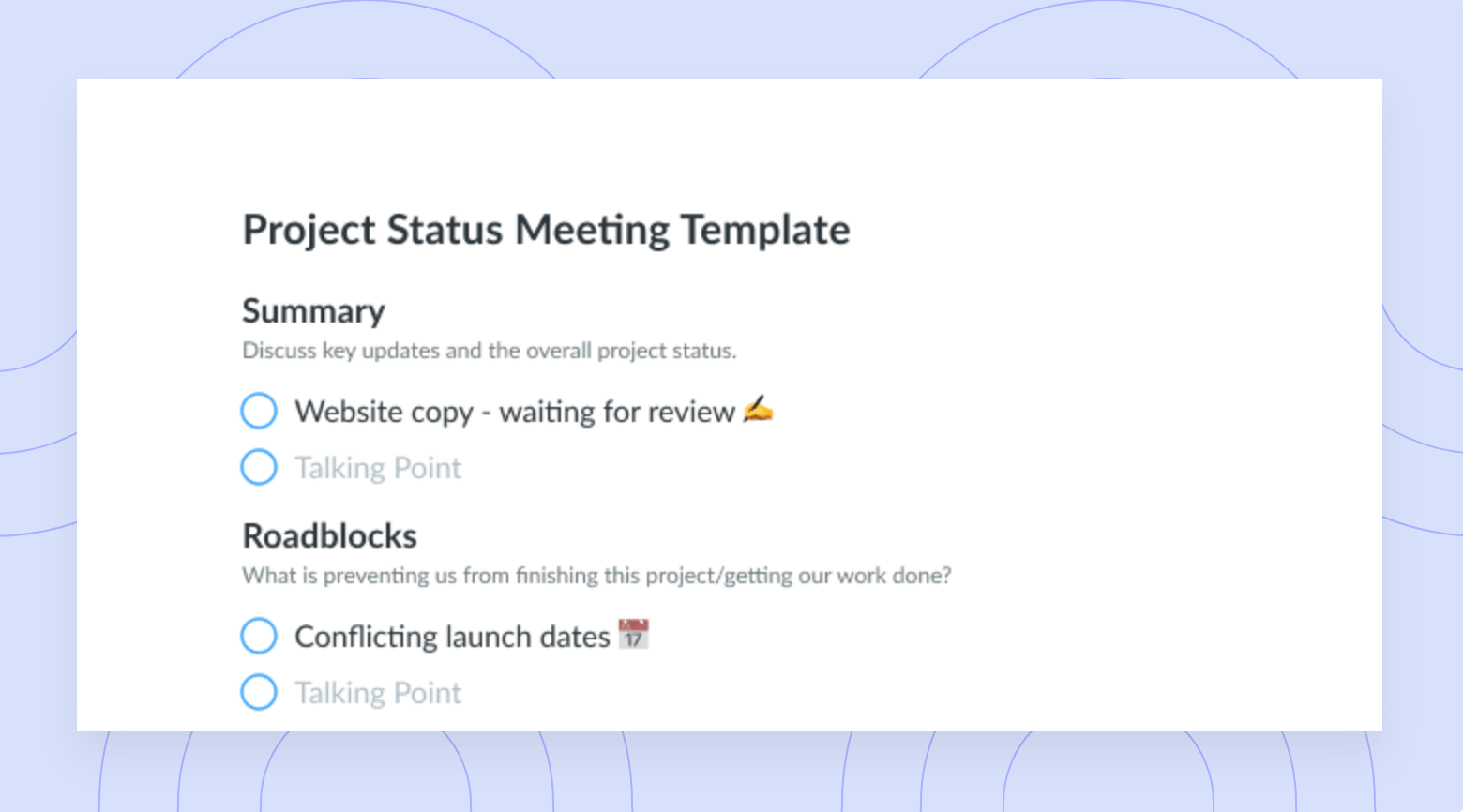
Design Team Meeting Agenda Template
Get this templateRun productive design team meetings where people showcase their work and share important updates.


Design Team Meeting Overview
“Design is intelligence made visible.” — Alina Wheeler, author
A design team meeting agenda is crucial for preparing for any design team meeting. Anyone who has ever taken part in regular design meetings knows that things can get hectic, and project directions can change at the drop of a hat based on client input and the current state of the potential outcome.
A good design team meeting should include the entire design team and management. If necessary, certain members from marketing or copywriting may need to attend. A design meeting aims to ensure that everyone is on the same page and presents any new information, as is the intention behind most group meetings and work conferences.
Design meetings should provide plenty of feedback regarding the current state of whatever project your team is working on, based on constructive, helpful criticism. Depending on the size and number of projects in the works, design team meetings can occur anywhere from a couple of times each week to once monthly.
It’s entirely up to you to decide what works or what actions are necessary to improve your design team’s workflow and operations consistently. Allow time for them to speak up as well, because frankly, design is crucial to company performance, and you’ll want to hear what they’ve got to say.
How to Run an Effective Design Team Meeting
“Make it simple, but significant.” — Don Draper, Mad Men
As always, an effective company team meeting begins with preparation. If your team meets regularly, they’re familiar with meeting times and expectations. You can email them a copy of the meeting plan and tell them you’ll see them there!
However, if you’re running your first design meeting ever, it helps to use a design meeting agenda to get into the groove, and you’ll likely continue to refer back to it time and time again. Before the meeting, contact your attendees and let them know what you need from them. Give them plenty of time to get it together, and don’t forget to include the talking points you intend to touch on so they can prepare questions or build off of those points.
You can’t prepare for a design team meeting if you’re clueless about where current projects stand. Communication with your design department is essential for marketing and branding success, so you’ll want to keep up with their daily workflow as much as possible despite frequent meetings.
You can find the components of our design meeting template in a design meeting agenda sample below!
What’s inside this Design Team Meeting Agenda Template:
1 💡 Updates
Kick off the meeting with updates. Let your team know what’s going on outside of design, as long as it pertains to design, and give them time to present project updates to you. There’s an explanation that goes along with specific phases in the design development creative process, so let your team explain and ask as many questions as possible.
When discussing updates, communication is crucial, so leaving ample time for it is non-negotiable. Ask everyone in attendance to take notes on the progress of the current projects, relay any expectations, and then move on to the next phase.
Each team member gets 2 minutes to explain what they worked on last week and what they’re planning to accomplish this week.
2 💬 Talking points
In this section, consider making a list of talking points you intend to bring up during the meeting. It’s encouraged for you to ask your attendees to do the same. You can easily download and email them a copy of the template, which will allow them to organize their thoughts.
Meetings are a time for communication, as it’s the literal intent behind every meeting. If companies didn’t need employees on the same page, meetings would cease to exist. Use your talking point section wisely, and if something comes up that can wait until later, gently express that fact.
Everyone on the team can add questions or topics they’d like to discuss. If you have a large group, you can vote on what to discuss now vs. later.
3 🎨 Show the thing (critique)
This section lets your designers show off how far they’ve come, opening their projects up to constructive critiques from other departments and, in some cases, design leads or clients. Remember that it’s rare for designs to check every box right away, and it’s common for you to have to request revisions.
However, it helps to have specifics in mind before critiques take place. Before the meeting, consider what you’re genuinely expecting to take away from the designs that require presenting. When you’ve got a firm grasp on your expectations, you can communicate them more effectively.
Anyone can share what they’re working on in this forum. In order to save time and encourage everyone to participate, your team can rotate who showcases their work each week.
4 ✅ Action items
What came out of this meeting? What are everyone’s next steps?
Most meetings wrap up with action items, and design meetings are no exception! Go over the discussion one more time, briefly, and then give some time to ask and answer any additional questions you could not address earlier. Finally, assign action items to team members and yourself.
Let them know, in detail, what you expect for the next meeting, and tell them you’ll email them with more information and anything you forgot to mention. When the meeting adjourns, everyone in attendance should know what’s just been added to their weekly schedule, but please stress to them that you’re there if they’ve got questions!



























